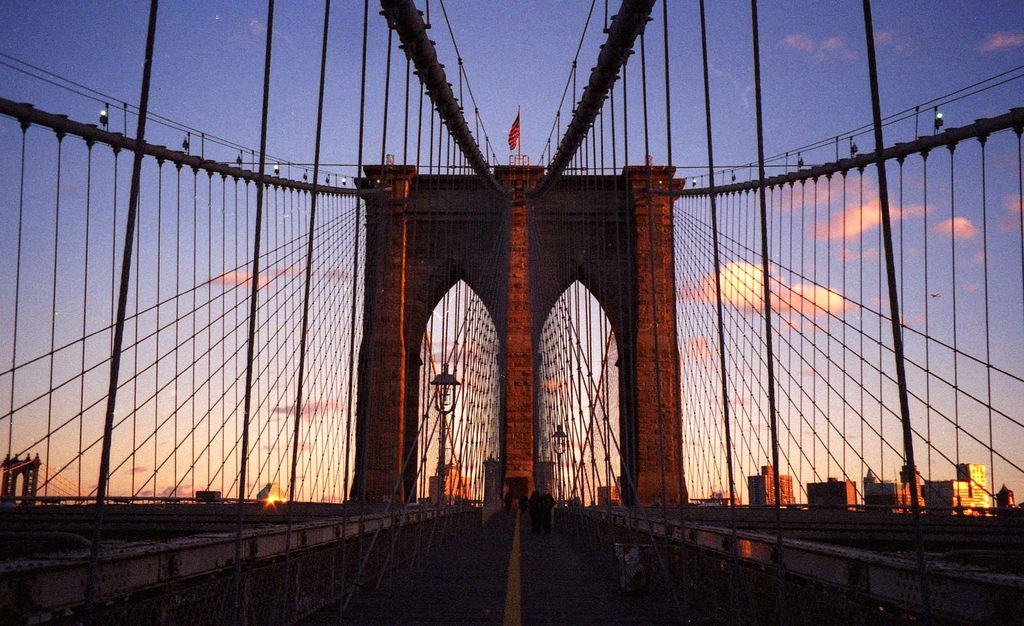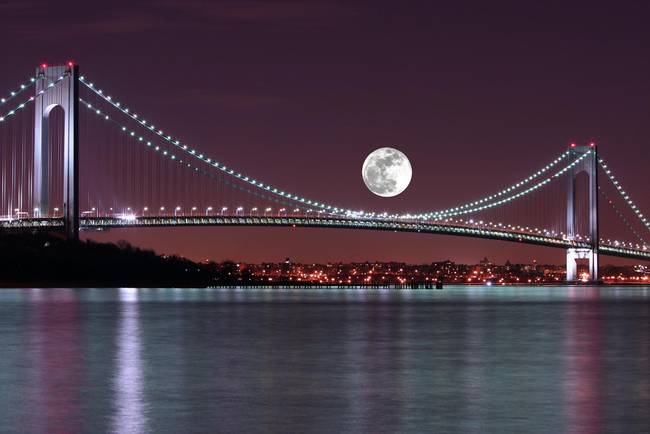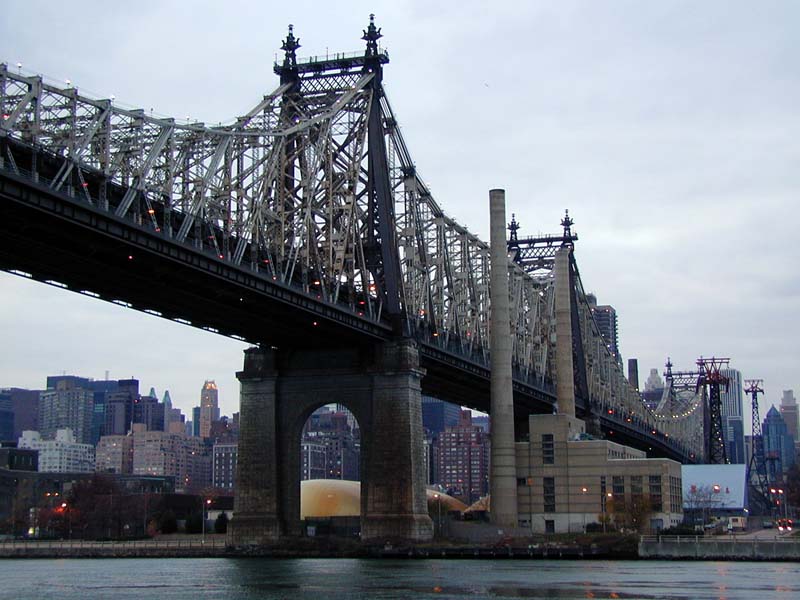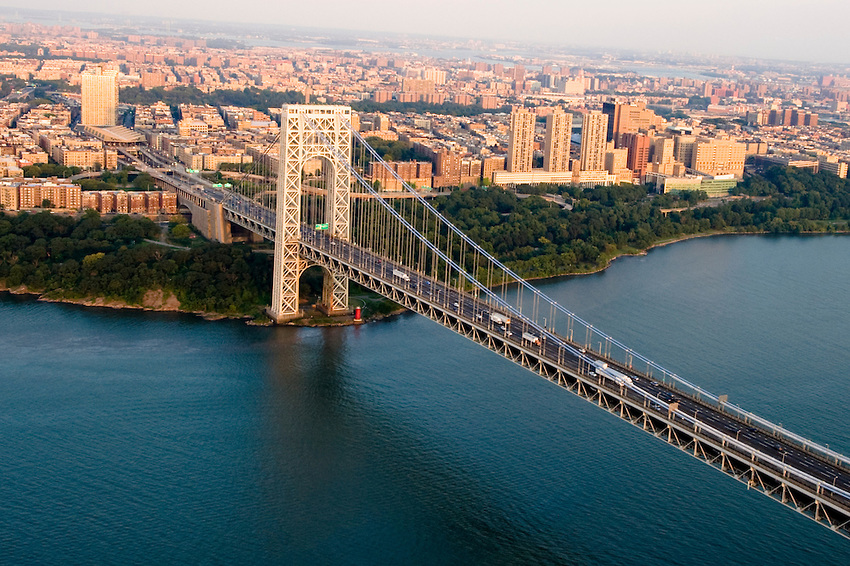Brooklyn Bridge.  View of the Brooklyn Bridge.
View of the Brooklyn Bridge.
Brookyln Bridge
The Brooklyn Bridge opened to the public on May 24, 1883,
thereby connecting Manhattan with Brooklyn for the first time. Dubbed
the "Eighth Wonder of the World," early visitors gawked at its immense
granite towers and thick steel cables, not to mention its birds-eye views.
The bridge, which took 14 years and around $15 million to complete, remains
among New York City’s top tourist attractions and a busy thoroughfare for
commuters.William M. "Boss" Tweed, the infamously corrupt head of New York City's
Tammany Hall political machine, latched on to the Brooklyn Bridge project from the
very beginning. According to sworn testimony he gave later, he facilitated up to
$65,000 in bribes to New York's aldermen in order to win their backing for a $1.5 million
bond issue. He then became a major holder of bridge stock and joined a committee charged with
managing the project's finances.
Manhattan Bridge  View of the Manhattan Bridge.
View of the Manhattan Bridge.
Manhattan Bridge
Manhattan Bridge, is suspension bridge over the East River connecting southeastern Manhattan with
western Brooklyn in New York City. The bridge first opened to traffic in 1909, eight years after construction started.
Construction began on the bridge in 1901 under the instruction of the New York City Department of Bridges commissioner
Gustav Lindenthal and the chief engineer R.S. Buck. Just three years later, however, local politicking was responsible for
the pair being replaced with George E. Best and Othniel Foster Nichols, respectively. The bridge design was based on deflection
theory, a new concept at the time that was developed by Joseph Melan and applied to the bridge by the chief engineer Leon Moisseiff.
This design saved in cost, material, and construction time. The bridge was officially opened to traffic on Dec. 31, 1909.
Verazano-Narrows Bridge View of the Verazano-Narrows Bridge.
View of the Verazano-Narrows Bridge.
Verazzano-Narrows Bridge
Opened on November 21, 1964, the Verrazano-Narrows Bridge celebrates its 50th anniversary this week, so we're honoring
the occasion by looking at some of the statistics, quirks, and interesting bits of info that make up the massive crossing's history.
From parachuting off its tower, to a cameo in Saturday Night Fever, to nearly 22 dozen light bulbs, here are 25 things you may not
have know about the bridge.The original discussion for crossing the Narrows began in 1888 — but that was for a tunnel. After a bridge was
proposed and the design nixed, they went back to the tunnel idea, and actuallybegan digging. The abandoned tunnels, which only went 150
feet but still remain, were nicknamed “Hylan’s Holes” after then-Mayor John F. Hylan, who championed the failed project.
Queensboro Bridge View of the Queensboro Bridge.
View of the Queensboro Bridge.
Queensboro Bridge
The Queensboro bridge opened to the public in 1909. A collaboration between the famed bridge engineer Gustav Lindenthal (1850-1935) and architect Henry Hornbostel, the Queensboro's massive,
silver-painted trusses span the East River between 59th Street in Manhattan and Long Island City in Queens and offer spectacular views of midtown
Manhattan, highlighted by the Empire State Building, the Chrysler Building, and the United Nations. Often referred to as the 59th Street Bridge,
the Queensboro’s completion preceded that of the Manhattan Bridge by nine months. When the bridge was completed it used to be the largest suspension bridge in the world. Now it's
in 11th place. This bridge was used in a scene of Spider-Man, the showdown between the Green Goblin and Spider-Man.
George Washington Bridge View of the George Washington Bridge.
View of the George Washington Bridge.
George Washington Bridge
The George Washington Bridge is a famous bridge that connects New York and New Jersey. This bridge is main road because it is more reliable to use to go
from north to south, vice-versa.The George Washington Bridge stands high above the Hudson River, its eastern end resting on the shores of Manhattan, its western end
embedded in the wooded bluffs of New Jersey's Palisades. Twice as long as any previous suspension bridge, it was the marvel of its time and, to some, it will always
be the noblest of all bridges. Spanning the river to link New York City and New Jersey had challenged planners and engineers for over 100 years before Othmar Ammann,
the brilliant, Swiss-born architect and engineer, proposed a bridge design in 1923 that ultimately was chosen above all others. The Port Authority, with Ammann as its
new chief engineer, began construction in October of 1927. Ammann's design, bold and foresighted, was an engineering tour de force, with an extraordinary 3,500-foot center
span suspended between two 570-foot steel towers, and the strength to carry two levels of roadway or rail. The George Washington Bridge was first opened to traffic in 1931.
During the first full year of operation in 1932 more than 5.5 million vehicles used the original six-lane roadway. As traffic demand increased, additional construction became
necessary. The two center lanes of the bridge, which had been left unpaved in the original construction, were opened to traffic in 1946, increasing capacity of the bridge by
one-third. The six lanes of the lower roadway were completed in 1962.
 View of the Brooklyn Bridge.
View of the Brooklyn Bridge. View of the Brooklyn Bridge.
View of the Brooklyn Bridge. View of the Manhattan Bridge.
View of the Manhattan Bridge.  View of the Verazano-Narrows Bridge.
View of the Verazano-Narrows Bridge.  View of the Queensboro Bridge.
View of the Queensboro Bridge.  View of the George Washington Bridge.
View of the George Washington Bridge.